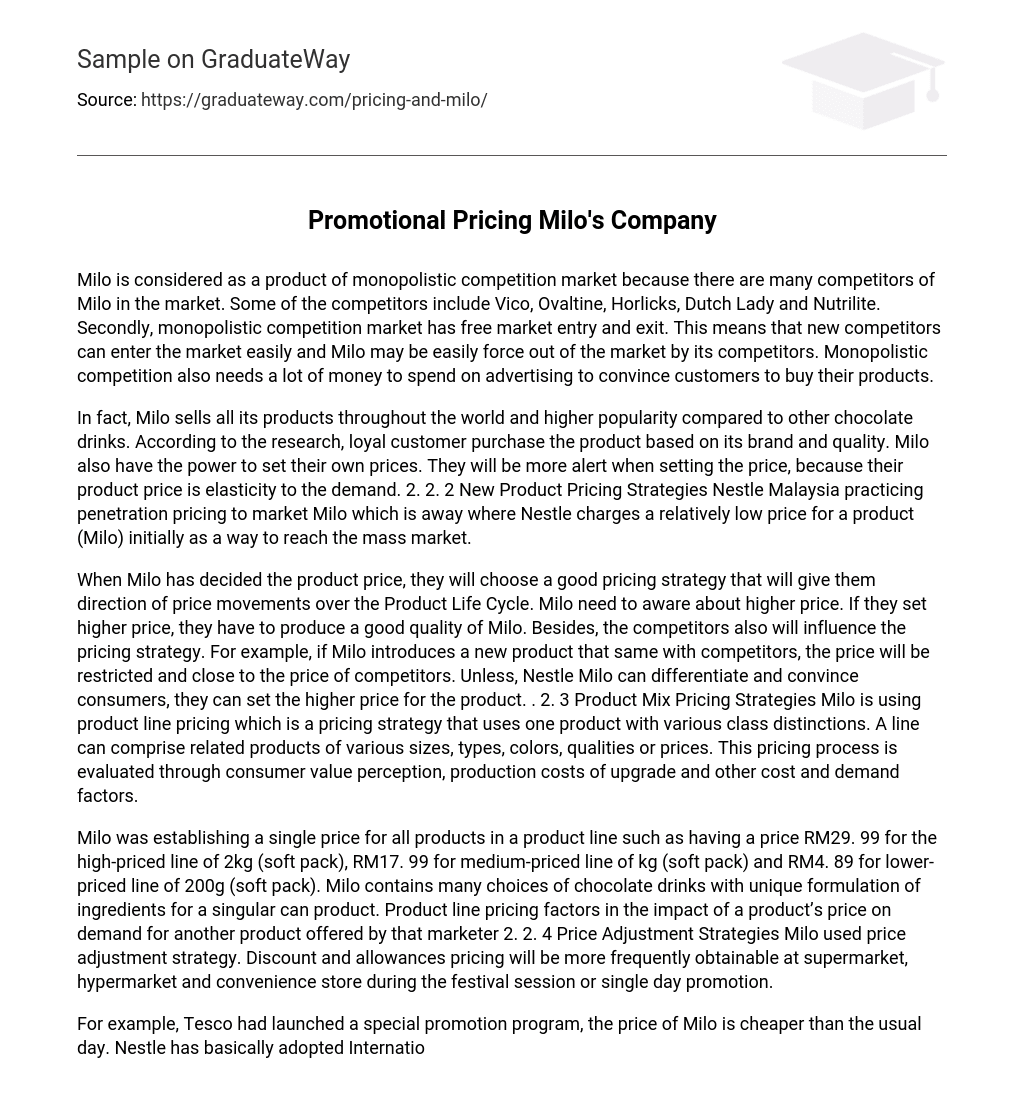Milo is considered as a product of monopolistic competition market because there are many competitors of Milo in the market. Some of the competitors include Vico, Ovaltine, Horlicks, Dutch Lady and Nutrilite. Secondly, monopolistic competition market has free market entry and exit. This means that new competitors can enter the market easily and Milo may be easily force out of the market by its competitors. Monopolistic competition also needs a lot of money to spend on advertising to convince customers to buy their products.
In fact, Milo sells all its products throughout the world and higher popularity compared to other chocolate drinks. According to the research, loyal customer purchase the product based on its brand and quality. Milo also have the power to set their own prices. They will be more alert when setting the price, because their product price is elasticity to the demand. 2. 2. 2 New Product Pricing Strategies Nestle Malaysia practicing penetration pricing to market Milo which is away where Nestle charges a relatively low price for a product (Milo) initially as a way to reach the mass market.
When Milo has decided the product price, they will choose a good pricing strategy that will give them direction of price movements over the Product Life Cycle. Milo need to aware about higher price. If they set higher price, they have to produce a good quality of Milo. Besides, the competitors also will influence the pricing strategy. For example, if Milo introduces a new product that same with competitors, the price will be restricted and close to the price of competitors. Unless, Nestle Milo can differentiate and convince consumers, they can set the higher price for the product. . 2. 3 Product Mix Pricing Strategies Milo is using product line pricing which is a pricing strategy that uses one product with various class distinctions. A line can comprise related products of various sizes, types, colors, qualities or prices. This pricing process is evaluated through consumer value perception, production costs of upgrade and other cost and demand factors.
Milo was establishing a single price for all products in a product line such as having a price RM29. 99 for the high-priced line of 2kg (soft pack), RM17. 99 for medium-priced line of kg (soft pack) and RM4. 89 for lower-priced line of 200g (soft pack). Milo contains many choices of chocolate drinks with unique formulation of ingredients for a singular can product. Product line pricing factors in the impact of a product’s price on demand for another product offered by that marketer 2. 2. 4 Price Adjustment Strategies Milo used price adjustment strategy. Discount and allowances pricing will be more frequently obtainable at supermarket, hypermarket and convenience store during the festival session or single day promotion.
For example, Tesco had launched a special promotion program, the price of Milo is cheaper than the usual day. Nestle has basically adopted International Pricing strategy for Milo. Companies that market their products internationally must decide what prices to charge in the different countries in which they operate. In some cases, a company can set a uniform worldwide price. The price that a company should charge in a specific country depends on many factors, including economic conditions, competitive situations, laws and regulations, and development of the wholesaling and retailing system.
Consumer perceptions and preferences also may vary from country to country, calling for different prices. Or the company may have different marketing objectives in various world markets, which require changes in pricing strategy. Costs play an important role in setting international prices. Travelers abroad are often surprised to find that goods that are relatively inexpensive at home may carry outrageously higher price tags in other countries.
Besides, such price escalation may result from differences in selling strategies or market conditions. In most instances, however, it is simply a result of the higher costs of selling in foreign markets such as the additional costs of modifying and packaging the product, higher shipping and insurance costs, import tariffs and taxes, costs associated with exchange rate fluctuations and higher channel and physical distribution costs. Futhermore, Milo also adopted Promotional Pricing strategy.
Selling products is challenging when shelves are lined with similar-quality products, and customers are bombarded with advertising messages. Promotional pricing helps differentiate Milo’s product with its competitor and leverage a potential customer’s attention long enough to purchase the Milo products. Promotional pricing involves lowering the price of a product, distributing coupons or offering specials, such as buy-one-get-one-free offers. For example, Milo offer promotional pricing for its product in weekly catalogue to create excitement and a sense of urgency.





